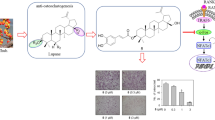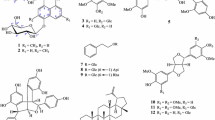Abstract
A new naphthalene glycoside was isolated from the leaves and stems of Chimaphila umbellata Barton. Its chemical structure was elucidated to be 2,7-dimethyl-1,4-dihydroxynaphthalene-1-O-β-d-glucopyranoside (DMDHNG), based on spectroscopic evidence. DMDHNG significantly inhibited the receptor activator of nuclear factor-κB ligand (RANKL)-induced tartrate-resistant acid phosphatase (TRAP) activity and the formation of multinucleated osteoclasts in a dose-dependent manner. In addition, the new glycoside inhibited the RANKL-induced mRNA expression of osteoclast-associated genes that encode TRAP, cathepsin K, and another transcription factor—nuclear factor of activated T-cells c1. We believe that the inhibitory effects of DMDHNG on the osteoclast differentiation may be exploited for a therapeutic benefit.




Similar content being viewed by others
References
Arnason, T., R.J. Hebda, and T. Johns. 1981. Use of plants for food and medicine by native peoples of eastern Canada. Canadian Journal of Botany 59: 2189–2325.
Balkan, W., M. Rodríguez-Gonzalez, M. Pang, I. Fernandez, and B.R. Troen. 2011. Retinoic acid inhibits NFATc1 expression and osteoclast differentiation. Journal of Bone and Mineral Metabolism 29: 652–661.
Choi, J.S., J.H. Jung, H.J. Lee, J.H. Lee, and S.S. Kang. 1995. A naphthalene glycoside from Cassia tora. Phytochemistry 40: 997–999.
Galván, I.J., N. Mir-Rashed, M. Jessulat, M. Atanya, A. Golshani, T. Durst, P. Petit, V.T. Amiguet, T. Boekhout, R. Summerbell, I. Cruz, J.T. Arnason, and M.L. Smith. 2008. Antifungal and antioxidant activities of the phytomedicine pipsissewa, Chimaphila umbellata. Phytochemistry 69: 738–746.
Han, N., T. Huang, Y.-C. Wang, J. Yin, and S. Kadota. 2011. Flavanone glycosides from Viscum coloratum and their inhibitory effects on osteoclast formation. Chemistry & Biodiversity 8: 1682–1688.
Jiao, L., D.-P. Cao, L.-P. Qin, T. Han, Q.-Y. Zhang, Z. Zhu, and F. Yan. 2009. Antiosteoporotic activity of phenolic compounds from Curculigo orchioides. Phytomedicine 16: 874–881.
Kyung, T.-W., J.-E. Lee, H.-H. Shin, and H.-S. Choi. 2008. Rutin inhibits osteoclast formation by decreasing reactive oxygen species and TNF-α by inhibiting activation of NF-κB. Experimental & Molecular Medicine 40: 52–58.
Lee, Z.H., and H.-H. Kim. 2003. Signal transduction by receptor activator of nuclear factor kappa B in osteoclasts. Biochemical and Biophysical Research Communications 305: 211–214.
Markham, K.R., B. Ternai, R. Stanley, H. Geiger, and T.J. Mabry. 1978. Carbon-13 NMR studies of flavonoids—III: Naturally occurring flavonoid glycosides and their acylated derivatives. Tetrahedron 34: 1389–1397.
Matsumoto, M., M. Kogawa, S. Wada, H. Takayanagi, M. Tsujimoto, S. Katayama, K. Hisatake, and Y. Nogi. 2004. Essential role of p38 mitogen-activated protein kinase in cathepsin K gene expression during osteoclastogenesis through association of NFATc1 and PU.1. Journal of Biological Chemistry 279: 45969–45979.
Minkin, C. 1982. Bone acid phosphatase: Tartrate-resistant acid phosphatase as a marker of osteoclast function. Calcified Tissue International 34: 285–290.
Oka, M., M. Tachibana, K. Noda, N. Inoue, M. Tanaka, and K. Kuwabara. 2007. Relevance of anti-reactive oxygen species activity to anti-inflammatory activity of components of Eviprostat®, a phytotherapeutic agent for benign prostatic hyperplasia. Phytomedicine 14: 465–472.
Regmi, A., T. Fuson, X. Yang, J. Kays, C. Moxham, E. Zartler, S. Chandrashekhar, and R.J.S. Galvin. 2005. Suramin interacts with RANK and inhibits RANKL-induced osteoclast differentiation. Bone 36: 284–291.
Saxena, G., S.W. Farmer, R.E.W. Hancock, and G.H.N. Towers. 1996. Chlorochimaphilin: A new antibiotic from Moneses uniflora. Journal of Natural Products 59: 62–65.
Sharma, S.M., A. Bronisz, R. Hu, K. Patel, K.C. Mansky, S. Sif, and M.C. Ostrowski. 2007. MITF and PU.1 recruit p38 MAPK and NFATc1 to target genes during osteoclast differentiation. Journal of Biological Chemistry 282: 15921–15929.
Song, M.-C., F. Nigussie, H.-J. Yang, H.-H. Kim, J.-Y. Kim, D.-K. Chung, and N.-I. Baek. 2008. Phenolic glycosides from Lindera fruticosa root and their inhibitory activity on osteoclast differentiation. Chemical & Pharmaceutical Bulletin 56: 707–710.
Takayanagi, H., S. Kim, T. Koga, H. Nishina, M. Isshiki, H. Yoshida, A. Saiura, M. Isobe, T. Yokochi, J.-I. Inoue, E.F. Wagner, T.W. Mak, T. Kodama, and T. Taniguchi. 2002. Induction and activation of the transcription factor NFATc1 (NFAT2) integrate RANKL signaling in terminal differentiation of osteoclasts. Developmental Cell 3: 889–901.
Trubachev, A.A., and V.S. Batyuk. 1968. Flavonoids of Chimaphila umbellata. Chemistry of Natural Compounds (Translation of Khimiya Prirodnykh Soedinenii) 4: 271–272.
Trubachev, A.A., and V.S. Batyuk. 1969. Phytochemical study of Chimaphila umbellata (L.) Nutt. Farmatsiia 18: 48–51.
Veitch, F.P., and P.A. Welton. 1951. β-amyrin from Chimaphila umbellata. Journal of the American Chemical Society 73: 3530.
Walewska, E., and H. Thieme. 1969. Isolation of isohomoarbutin from Chimaphila umbellata (L.) Barton. Pharmazie 24: 423.
Wang, J.-F., F.-Q. Xu, Z. Wang, X. Lu, J.-T. Wan, B. Yang, X.-F. Zhou, T.-Y. Zhang, Z.-C. Tu, and Y. Liu. 2014. A new naphthalene glycoside from the sponge-derived fungus Arthrinium sp. ZSDS1-F3. Natural Product Research 28: 1070–1074.
Yang, Q.-Y., C.-S. Yao, and W.-S. Fang. 2010. A new triglucosylated naphthalene glycoside from Aloe vera L. Fitoterapia 81: 59–62.
Yoon, K.D., D.G. Jeong, Y.H. Hwang, J.M. Ryu, and J. Kim. 2007. Inhibitors of osteoclast differentiation from Cephalotaxus koreana. Journal of Natural Products 70: 2029–2032.
Zellnig, K., A. Michelitsch, W. Likussar, M. Schubert-Zsilavecz, A. Baumesiter, and Z.B. Salama. 1996. Polarographic assay of chimaphilin in Chimaphila umbellata primary tincture. European Journal of Pharmaceutical Sciences 4(Supplement 1): S127.
Zhang, H., Z. Guo, N. Wu, W. Xu, L. Han, N. Li, and Y. Han. 2012. Two novel naphthalene glucosides and an anthraquinone isolated from Rumex dentatus and their antiproliferation activities in four cell lines. Molecules 17: 843–850.
Acknowledgments
This work was supported by the Bio-Synergy Research Project (NRF-2012M3A9C4048796) of the Ministry of Science, ICT and Future Planning through the National Research Foundation. The authors wish to acknowledge the financial support of Gachon University Research Fund.
Conflict of interest
The authors declare no conflict of interest.
Author information
Authors and Affiliations
Corresponding authors
Additional information
Byong-kyu Shin and Jinhee Kim contributed equally to this work.
Rights and permissions
About this article
Cite this article
Shin, Bk., Kim, J., Kang, K.S. et al. A new naphthalene glycoside from Chimaphila umbellata inhibits the RANKL-stimulated osteoclast differentiation. Arch. Pharm. Res. 38, 2059–2065 (2015). https://doi.org/10.1007/s12272-015-0598-3
Received:
Accepted:
Published:
Issue Date:
DOI: https://doi.org/10.1007/s12272-015-0598-3




